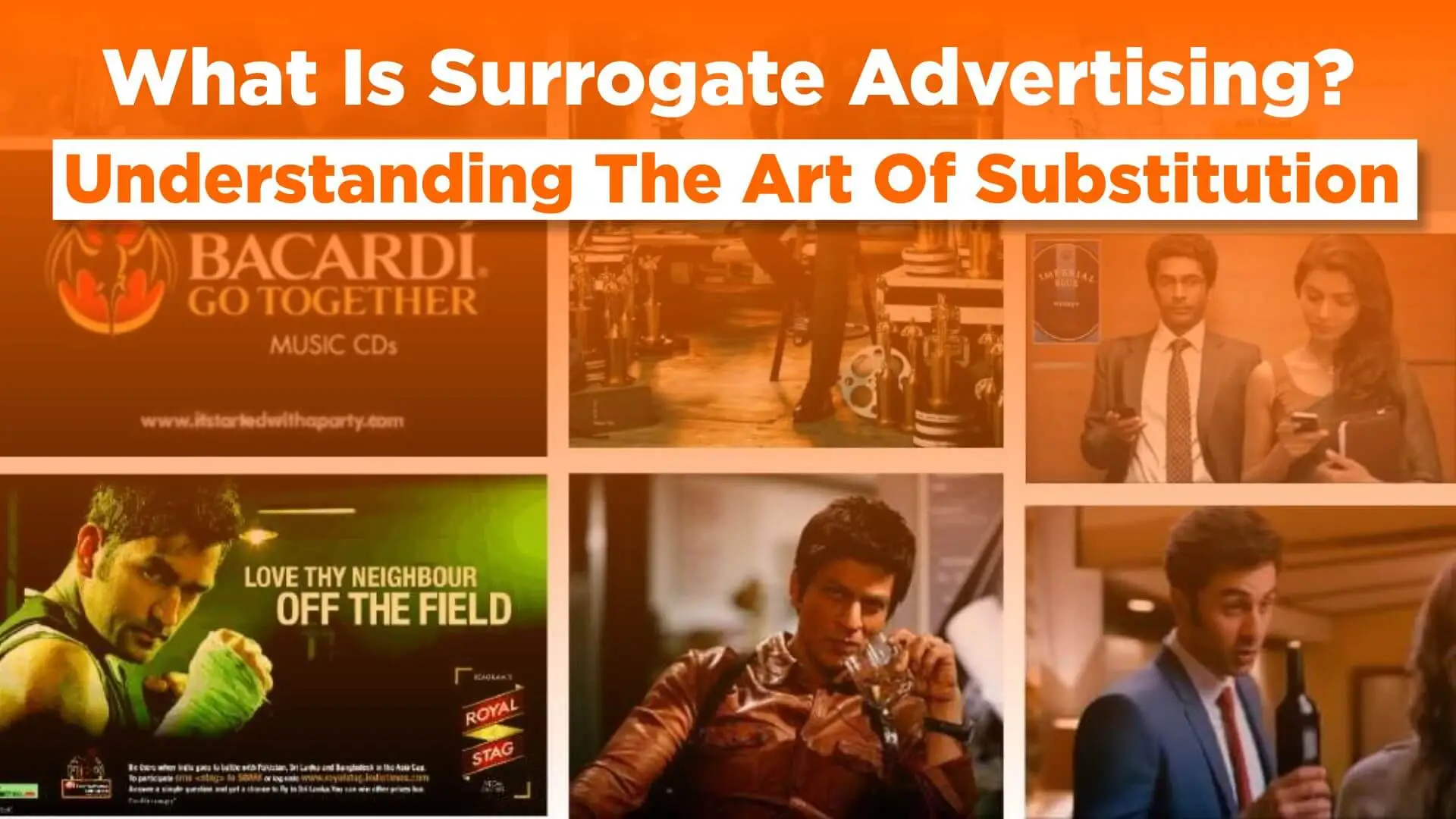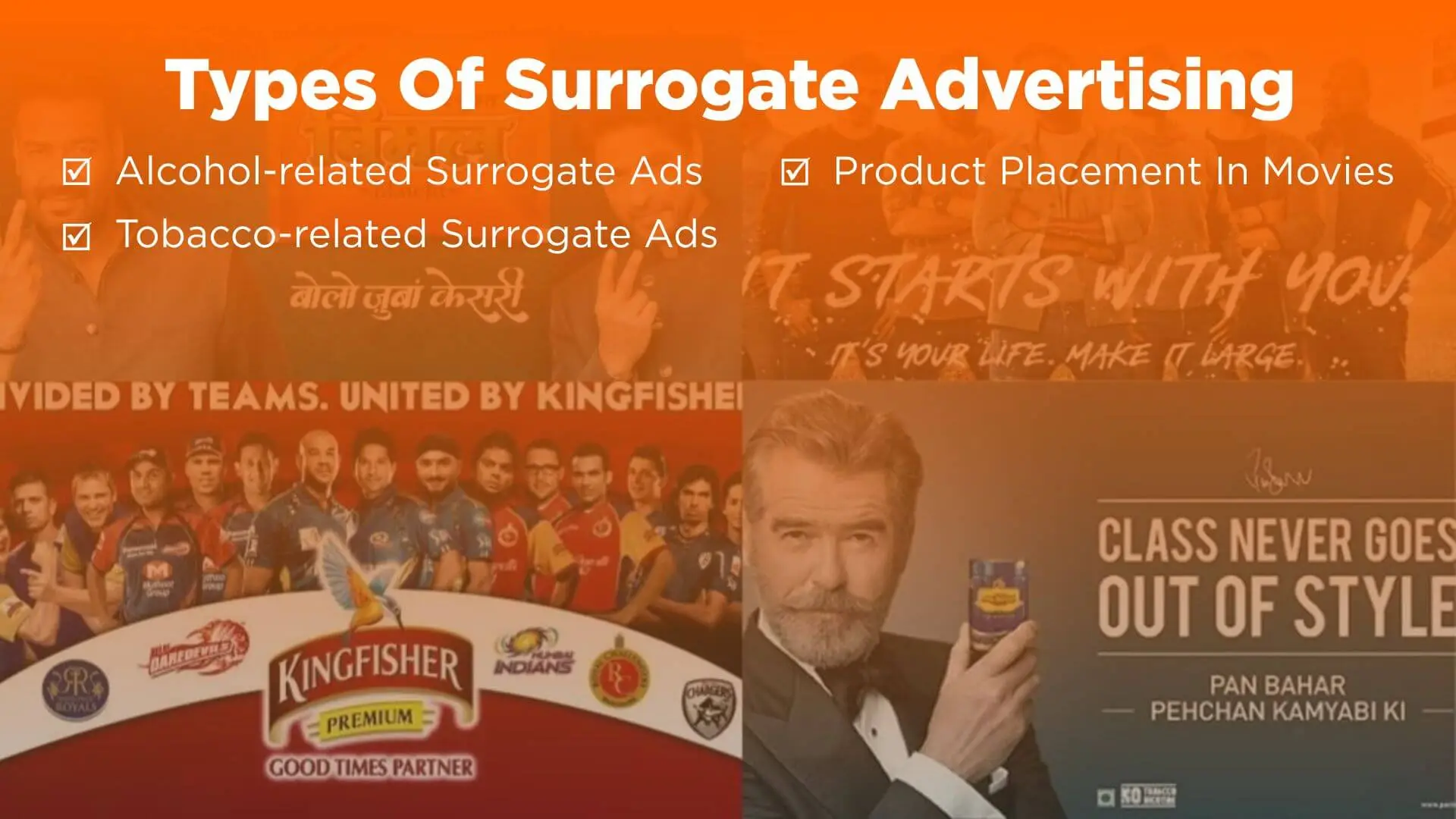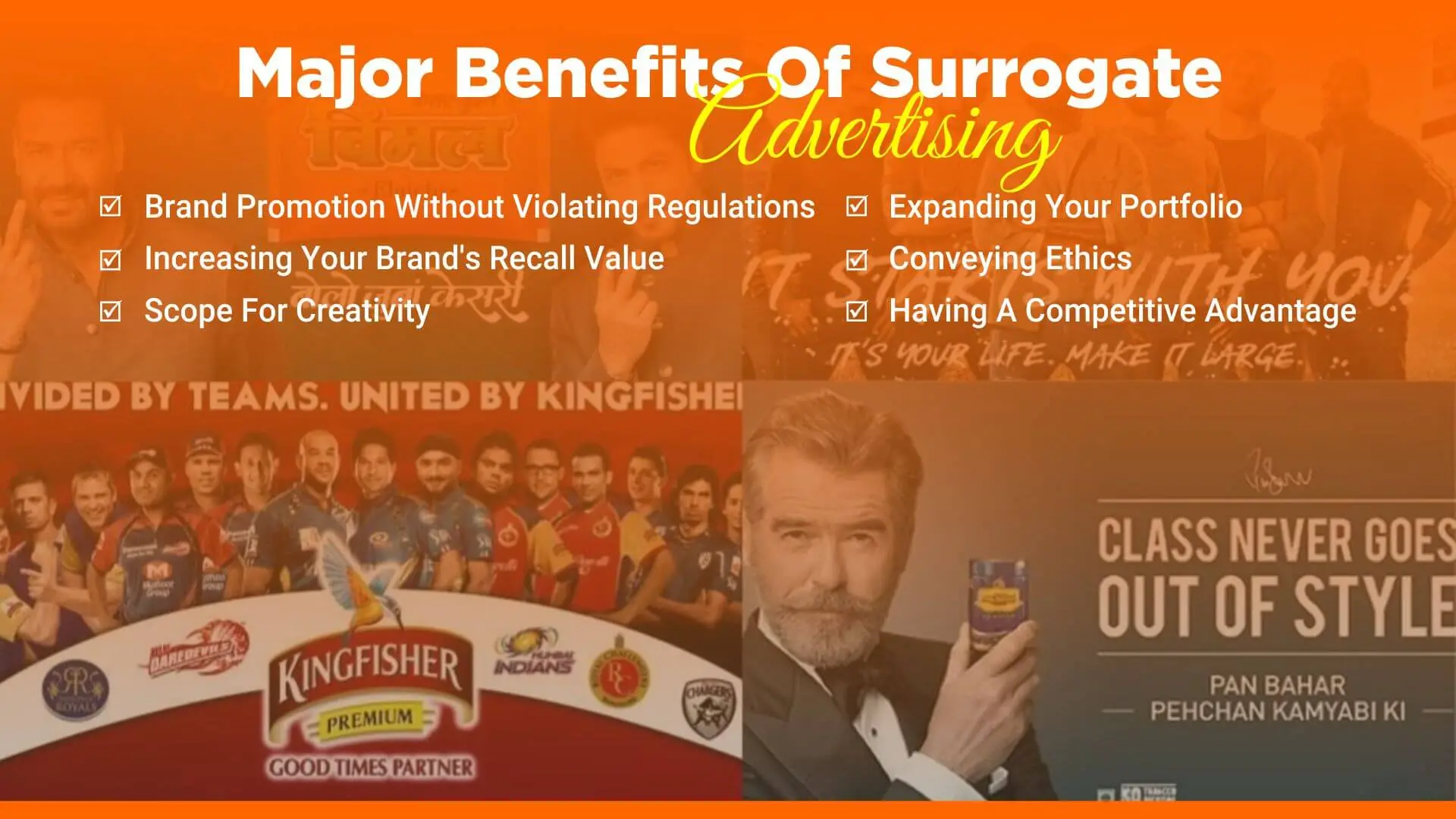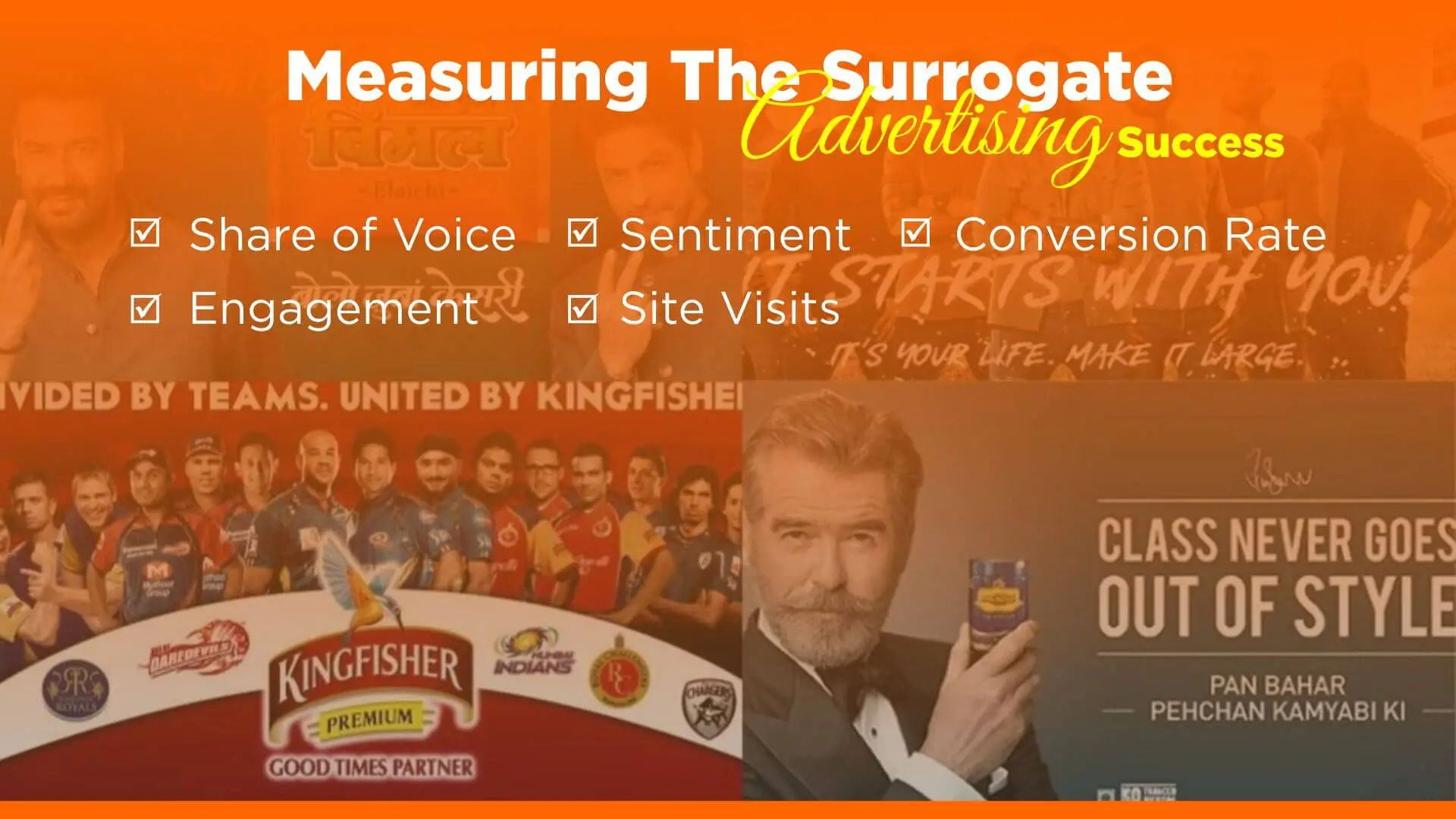What Is Surrogate Advertising? Understanding The Art Of Substitution

What Is Surrogate Advertising? Understanding The Art Of Substitution
Advertising has been one of the most popular and effective ways of building brands for several decades. Being one of the key marketing pillars, it allows brands to reach out to their audiences directly and ask them to purchase their products or services.
However, there are instances where advertising cannot be 100% direct.
Depending on the country you live in, you may not be allowed to promote the sale of certain products directly. From tobacco to alcohol, companies manufacturing and selling several products are restricted by the Government to put out ads asking the target audience to make purchases.
However, while direct advertising of such products is not allowed, the sale of these products is legal. Considering this, brands choose the middle way out to maintain their image in the market without violating any regulations.
This is the way of surrogate advertising.
What Is Surrogate Advertising?
The word “surrogate” refers to “substitute.” Surrogate advertising is the process of using a brand’s name, logo, and essence to sell a product/service it is not popularly known for. In simple words, it involves brands promoting legally admissible products or services instead of the ones that are not.
In India, surrogate ads are common and used across several media platforms. You must have seen liquor brands using their brand names and logos to promote products like music CDs, soda, and more. While the target audience knows a particular brand’s niche, surrogate advertising helps you get your message across in a subtle and legal way.
Surrogate advertising is often used by companies whose products cannot be marketed directly. From liquor to tobacco-related products, several brands have embraced this form of advertising to spread their word and uphold their image in the industry.
Talking about surrogate advertising vs. direct advertising, the difference lies only in the products/services being advertised. Everything else, from the use of logos to production value, remains the same. The surrogate products promoted by a brand may or may not be related to the product it is restricted from advertising. For example, a liquor company may choose to sell soda bottles or music CDs through surrogate advertising.
Types Of Surrogate Advertising

There are enough surrogate advertising examples across multiple media platforms to understand its different types. You can distinguish these ads by the domains the brands operate in and the means they use to get their messages across.
Let us have a look at the different types of surrogate advertising common in India:
Alcohol-related Surrogate Ads
While the sale of liquor is legal in India, the Government does not allow brands to promote alcohol-related products through advertisement. This is what allows them to create alcohol-related surrogate ads. These ads promote items that are related to or in a completely different league than alcohol.
You must have seen the immensely popular series of ads by a popular liquor brand promoting music CDs. Several liquor companies choose to advertise sodas, glasses, or other accessories related to drinking alcohol to stay as close to their core products as possible.
As direct advertising of liquor is not restricted in all countries, liquor brands entering India have no option but to create alcohol-related surrogate ads to reach their audiences. From premium single malts to beers, every alcoholic beverage needs creative surrogate advertising to let people know about its existence.
Tobacco-related Surrogate Ads
The tobacco industry is another major sector heavily producing surrogate ads. Tobacco-related surrogate ads involve brands promoting products like mouth fresheners, cardamom, etc. instead of their core line of products.
Some of the biggest tobacco companies in the country use surrogate advertising to promote their products without violating the Government’s regulations. Being a financially affluent industry, it is also known to rope in some of the biggest celebrities to star in such tobacco-related surrogate ads.
Product Placement In Movies
In India, cinema is no less than a religion. Every weekend, people flock to a plethora of theaters across the country to witness their favorite stars and enjoy entertaining movies. Considering the immense popularity of this medium, several brands go for product placements in movies as a means of surrogate advertising.
Here, the products of specific brands (with their logos clearly visible) appear in critical scenes in movies. In most cases, the actors are seen using the products to drive the advertising message home. Without directly asking the audience to purchase their products, brands subtly place their products in popular movies to promote them.
Major Benefits Of Surrogate Advertising

If you are planning to develop a surrogate advertising campaign for your brand, let us have a look at a few benefits of the same:
Brand Promotion Without Violating Regulations
If you deal in products or services whose direct marketing is prohibited by the Government, surrogate advertising helps you spread your word without violating Government regulations. It allows you to operate within the framework of existing laws and reach your target audience in a discreet manner.
Increasing Your Brand’s Recall Value
Even if a brand is popular, it needs enough recall value to stay relevant in the market. Especially in domains like the liquor and tobacco industries, cut-throat competition requires brands to stay in their customers’ minds all the time. Surrogate advertising helps you increase your brand’s recall value by creating ads that solidify its image in your customers’ heads. At the end of the day, it is all about getting into your audience’s psyche and staying there for a long period of time!
Scope For Creativity
Some of the most unique ideas emerge from restrictions. When you are restricted in creating ads for your products, you are forced to work your way around the restrictions in an innovative way. This leads to the creation of some of the most memorable ads in the history of advertising! It is impossible to forget the Imperial Blue ads revolving around the theme of “men will be men.”
When you are restricted to spreading brand awareness through surrogate ads, you can let your ideas flow and prove that creativity knows no bounds!
Expanding Your Portfolio
While the focus of most surrogate ads is to promote products that are not displayed in the ads, they can actually help you open a new line of products. Let’s say you own a liquor brand and produce ads about your brand’s glasses. If the ads do well and the branded glasses find enough buyers, you can expand your portfolio by selling glasses. This can also help you expand your customer base by reaching individuals who did not belong to your target audience earlier.
Conveying Ethics
Surrogate advertising can also be a means to convey your brand’s essence without promoting products that are potentially harmful to the target audience. Most liquor and tobacco brands are accused of being amoral and unethical in their approaches. Surrogate ads allow such a company to put its tender side on display and convey the ethics and core values it believes in. This helps you win over new customers and leverage the loyalty of the existing ones.
Having A Competitive Advantage
If you are operating in a highly competitive industry, surrogate advertising gives you an edge over your competitors. Creating a surrogate ad requires high creativity and multiple skills not everyone possesses. If you succeed in producing an ad capable of making its mark, you can enjoy a competitive advantage over all players in the market!
Strategies To Implement Surrogate Advertising
Surrogate advertising can get really tricky and challenging if you do not know how to package your marketing message in a harmless and subtle ad. It requires seamless collaboration with expert advertisers. There are five major strategies followed by brands across the country in implementing surrogate advertising into their marketing campaigns.
Here are the surrogate advertising strategies you should know before you kickstart your campaign:
Promotion By Extension
This is the most common surrogate advertising strategy used by brands to promote their brands. As the name suggests, this involves extending a company’s umbrella of products by adding items that can be promoted through ads. For example, liquor brands promote items like glasses and soda cans after adding them to their portfolios. This strategy allows your brand name to appear in all your ads, creating its recall value for your customers.
Promotion By Association
This is the subtle strategy of using aural, visual, or thematic cues that help the audience associate the concerned ad with the product that cannot be advertised. From colors and themes to popular jingles, brands incorporate elements that make viewers think of nothing else but the product(s) sold by them. Here, a brand’s aim is to evoke feelings and memories related to consuming the products it sells. Many brands also use celebrities to get their messages across in a subtle but effective way.
Promotion Through Television Commercials
Almost every brand using surrogate advertising creates engaging television commercials to promote itself. Brands choose to create innovative and quirky ads with high production value to grab the viewers’ attention. Here as well, they may use celebrities representing the essence of the products being sold. As companies cannot endorse their flagship products, they are forced to create aesthetic and innovative ads to create their brands’ recall value.
Promotion Through Sponsorships And Events
Here, a brand’s goal is to promote itself by sponsoring events, having their banners put up at events, setting up kiosks selling their products, and more. This is the on-ground surrogate advertising strategy focused on creating high brand visibility and recall value.
You must have seen liquor brands organizing concerts and music events. At such events, the brand’s name gets so integrated with the events that it stays in the minds of the attendees.
Promotion Through PSAs
This is a surrogate advertising strategy where brands associate them with specific social causes and issue public service announcements (PSAs) in their names. It is often a tool to show a brand as being socially responsible and ethical without directly promoting its products or services. While there is no mention of a brand’s products, an impactful PSA imprints its name in the audience’s mind for a long time.
Measuring The Surrogate Advertising Success

Surrogate advertising is not limited to creating and publishing/broadcasting ads selling products other than the ones a brand is known for. It also involves measuring the success of these ads and analyzing their impact on the target audience. Every brand has a unique set of KPIs for surrogate ads that help marketers quantify the effectiveness of a campaign.
Surrogate advertising analytics also help brands make necessary changes to their campaigns and alter specific aspects to create more impactful ads. The KPIs a brand implements for surrogate advertising depend on the medium of propagation, industry, and other relevant factors.
Here are some of the most common surrogate advertising KPIs used by brands in 2023:
Share of Voice
Share of Voice (SOV) refers to the market owned by your brand as compared to your competitors. Used commonly for social media ads, it is determined by individuals and media houses talking about your brand and your ad on a specific platform. Naturally, your SOV will be higher if the chatter around your brand is more.
Engagement
Another common KPI used for surrogate advertising in social media, engagement deals with the interaction people have with your ads. Such engagement can be measured in the form of likes, shares, comments, retweets, etc.
Sentiment
Sentiment allows brands to focus on the overall mood created by their surrogate ads. A sentiment can be neutral, positive, or negative. Brands do their best to generate a higher positive sentiment to improve their market performance.
Site Visits
If your ad’s aim is to bring more people to your company’s official website or an eCommerce portal, the number of site visits dictates the success of your campaign. Here, brands measure the effectiveness of their campaigns by the number of people clicking on links leading to specific websites.
Conversion Rate
This is the ultimate KPI for any advertising campaign. It determines the rate of audience conversation, i.e., following the intended call-to-action of the ad. From landing on a specific website to making a purchase, conversion may have different meanings for different brands.
Understanding The Legal Aspects Of Surrogate Advertising
Surrogate advertising is a tricky business and requires you to walk on a thin line of legal regulations. It demands brands to promote themselves without giving any hint about the products they cannot advertise directly. If you end up violating these regulations, your company will face dire circumstances.
If you wish to create a surrogate advertising campaign in India, it is important to understand the Cable Television Networks (Amendment) Act and Cigarettes and Other Tobacco Products Act (COTPA) 2003. COTPA prevents companies from directly or indirectly promoting tobacco products on any media platform. The same holds true for alcoholic beverages. Moreover, no such promotions are allowed to be broadcast on television. While social media platforms enjoy some leniency, no direct advertising of tobacco or alcohol-related products is allowed on national television.
While the legal guidelines are clear, brands often struggle with determining the extent of an ad directly or indirectly promoting such products. Regulatory bodies like the Ministry of Information and Broadcasting (MIB) and the Advertising Standards Council of India (ASCI) are responsible for ensuring compliance and monitoring surrogate ads of all brands as they appear on media platforms. If you have any queries or confusion regarding surrogate ads, you can always approach these regulatory bodies for clarification.
Popular Surrogate Advertising Examples
Surrogate advertising is all around us with brands creating ads for all media platforms. From YouTube ads to ads featured on national television, there are countless surrogate advertising examples to study and learn from.
Here are five of the most popular examples of surrogate advertising campaigns created by prominent brands:
Kingfisher
When it comes to surrogate advertising, the first brand name that comes to mind is Kingfisher. Known for its beers across India and abroad, the company has often advertised its airlines, mineral water bottles, and other ventures across multiple platforms. It has also given us its immensely popular jingle that has kept the brand in our heads for several years. Kingfisher also sponsors several events and concerts to have its logo featured at venues, posters, hoarding, and across several platforms.
Bagpiper
A popular Indian whiskey brand, Bagpiper is known for its surrogate ads selling soda. The iconic tagline, “khoob jamega rang, jab mil baithenge teen yaar…” has stayed with Indians for several years. Without mentioning or showing its core product, Bagpiper managed to create a recall value for its brand through multiple television commercials. It also roped in a celebrity like Ajay Devgn to drive its message far and wide.
Imperial Blue
If there is any brand that made the most of surrogate advertising, it is Imperial Blue. Another popular whiskey brand in India, Imperial Blue’s ads sell music CDs and men’s accessories. For almost two decades, the brand has been creating quirky video ads revolving around the theme of “men will be men.” These ads have found their niche and showcased top-notch advertising skills through a campaign that reached every Indian household.
McDowell’s
Yet another Indian whiskey brand, McDowell’s has been pulling off an effective surrogate advertising campaign with its video ads and a jingle focusing on “No.1 Yaari.” Showcasing different facets of friendships, these ads promote McDowell’s soda. Interestingly, the brand’s soda bottles have been doing equally well in the market along with its flagship product.
Royal Challenge
If you are a Royal Challengers Bangalore fan, you have unknowingly been a part of a masterfully crafted surrogate advertising campaign! Royal Challenge whiskey often sells its sports drink through video ads featuring some of India’s most popular crickets. After giving its name to an IPL team, the name Royal Challenge has become etched in every Indian’s memory forever!
Frequently Asked Questions About Surrogate Advertising
It is legal to create surrogate ads?
Yes, it is legal to create surrogate ads as long as they comply with the ongoing laws and regulations of the country. If you make ads that do not directly or indirectly promote the sale of products whose advertising is prohibited by the Government of India, you can make as many surrogate ads for your brand as you want.
How will surrogate advertising help my business?
Surrogate advertising will prevent your business from missing out on traction simply because you cannot directly promote your key products or services. It allows you to bring your brand to the notice of your target audience and gives you a middle way out to promote your business. With surrogate advertising, you can wear your creative hats and think of the best way to convey your brand’s essence across the right media platforms.
Should I be concerned with the ethical implications of surrogate advertising?
Yes, ethics always play an important role in advertising, especially in a country like India. While the “men will be men” ads of Imperial Blue are loved by a large section of society, they are often called out for messages of misogyny and sexism. If you wish to create an engaging and effective surrogate advertising campaign, it is important to be sensitive and aware of your messaging.
Is surrogate advertising an effective long-term marketing strategy?
Absolutely! Brands like Imperial Blue, Kingfisher, and McDowell’s have been successful in creating a lasting brand image for several years. People still re-watch older surrogate ads for their creativity and effectiveness. Moreover, brands like Royal Challenge have become almost immortal by giving their names to IPL teams. If you choose the right media platforms and come up with innovative ideas, surrogate advertising can always be an effective long-term marketing strategy.
The Final Word
Surrogate advertising is an interesting yet challenging feat to achieve. If you deal in products or services that cannot be promoted openly, make sure you hire the right advertising agency in India to help you create impactful surrogate ads. Before you kick-start your campaign, ensure that your ads are ethical and do not hurt the sentiments of any of your target audiences.

Blog Admin:
Ravinder Bharti
CEO & Founder - Public Media Solution
About: Ravinder Bharti is the Founder and CEO of Public Media Solution,
a leading
marketing, PR, and branding company based in India.